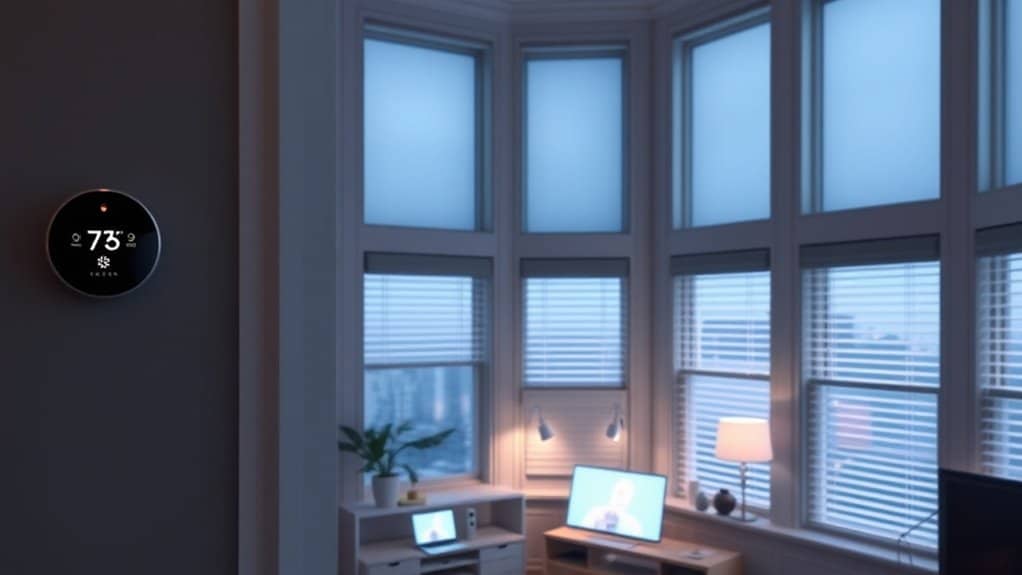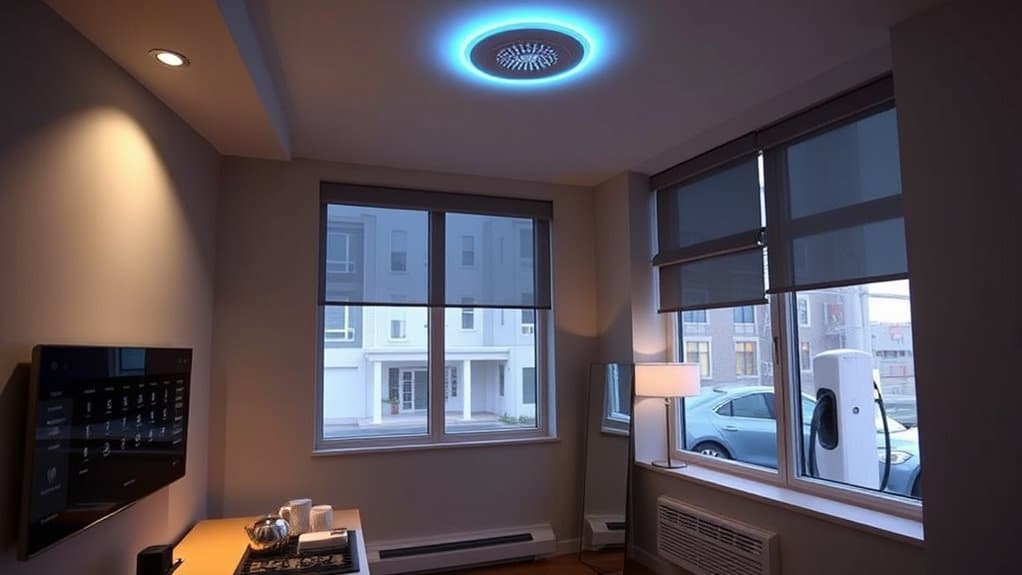Setting up a smart home in San Francisco requires careful planning of essential devices and connectivity solutions. You'll need to start with reliable internet through fiber or cable providers, then add smart security systems with 1080p cameras and video doorbells. Voice control integration, automated lighting, and energy management systems help maximize efficiency and comfort. Smart thermostats and AI-powered automation can reduce costs while increasing property value. The expanding tech infrastructure in SF offers even more possibilities for home innovation.
Essential Smart Home Devices for SF Living

While setting up a smart home in San Francisco requires careful planning, you'll want to start with essential devices that enhance security, convenience, and connectivity.
Begin with a smart security system featuring 1080p cameras and video doorbells that offer real-time monitoring and facial recognition capabilities. Add voice control through Amazon Alexa or Google Nest Audio to manage your home's functions effortlessly.
Incorporate smart lighting that you can control through voice commands or automated schedules, making your home more energy-efficient and secure.
For thorough coverage, install a wireless mesh network system to guarantee reliable connectivity throughout your space. Consider integrating a Matter-certified hub to unite your devices across different ecosystems, allowing seamless control of your security cameras, thermostats, and entertainment systems from a single platform.
Energy Management Systems and Sustainability
As San Francisco leads the charge in energy sustainability, you'll need to understand the city's extensive approach to energy management in residential settings.
The city's benchmarking program requires you to track and report your home's energy usage, helping you compare consumption with similar properties and identify areas for improvement.
You can leverage tools like the Bay Area Energy Atlas to analyze your home's energy efficiency against regional patterns, while taking advantage of municipal incentives for sustainability practices.
Through SFPUC's energy management systems, you'll gain access to detailed data about your property's performance and opportunities for upgrades.
The city's mandatory reporting guarantees you're accountable for your energy consumption, while providing resources to help you implement cost-effective solutions, from HVAC optimization to improved insulation systems.
Security Features for Urban Smart Homes
Living in San Francisco's urban environment requires an all-encompassing security setup for your smart home.
Today's urban safety innovations include AI-powered surveillance systems that can distinguish between regular visitors and potential threats, while smart surveillance trends focus on seamless integration with your daily routines.
You'll find your security enhanced through video doorbells that let you monitor visitors remotely, and outdoor cameras with night vision that'll send instant alerts to your smartphone.
The system's AI analyzes behavioral patterns and triggers automated responses, like flooding suspicious areas with light or notifying authorities.
You can control everything through voice commands or your smartphone, while encrypted connections keep your data secure.
For added peace of mind, you'll have access to 24/7 professional monitoring services and backup power systems.
Connectivity Solutions in the Bay Area

A robust internet connection forms the backbone of any modern smart home in San Francisco.
You'll find extensive fiber availability through providers like AT&T and Sonic, offering speeds up to 10 Gbps in select neighborhoods. While fiber reaches 55.03% of households, cable internet dominates with nearly 99% coverage through Xfinity and Spectrum.
For areas where traditional wired connections aren't available, wireless options include Verizon's 5G Home Internet, covering 56.9% of the city.
You'll also find satellite providers like Viasat and Starlink offering citywide coverage, though at lower speeds.
The city's Fiber-to-Housing Program is expanding connectivity further, aiming to connect 30,000 affordable housing units by 2025, ensuring more residents have access to high-speed internet for their smart home needs.
Property Value Impact of Tech Integration
When you're considering tech upgrades for your San Francisco home, you'll find that smart home features can boost your property's value by up to 5%. This aligns with national premium trends where smart homes command nearly double the price of traditional properties.
You'll notice that buyers in the Bay Area are particularly drawn to homes with extensive smart security systems and energy management solutions, making these installations particularly valuable in the local market.
The combination of San Francisco's tech-savvy population and the growing demand for connected homes means you'll likely see strong returns on your smart home investments, especially with features like automated climate controls and integrated security systems that can lead to insurance savings of up to 20%.
Smart Home Price Premiums
Smart home technology greatly impacts property values, with tech-enabled homes commanding an average price of $1.2M compared to $660K for traditional homes nationwide.
Your smart home investments can lead to significant returns, as installing these features typically boosts property values by 5%. Tech market trends show particularly strong premiums in major metropolitan areas like Los Angeles, New York, and Dallas.
You'll find the highest price differences in southern California and New York markets, where affluent buyers actively seek connected homes.
While smart security systems can reduce your insurance costs by up to 20%, they're also driving faster sales. In fact, 28% of Americans would pay an $18,000+ premium for smart features, making these upgrades increasingly attractive for homeowners looking to maximize their property's value.
Digital Infrastructure Valuations
Modern digital infrastructure substantially shapes property values, with data centers and broadband connectivity emerging as key drivers in real estate markets.
You'll find that homes with robust broadband access typically see an 8% increase in value, while areas with data centers experience even more dramatic valuation impacts.
In tech-heavy regions like Loudoun County, you're witnessing unprecedented growth, where data center developments have pushed commercial property values up by 45%.
When you're assessing a property's worth, you'll need to take into account its digital infrastructure capabilities, as they're now as vital as traditional utilities.
Smart building features can boost operational efficiency by up to 40%, directly affecting your property's market value.
These technological improvements aren't just amenities anymore - they're essential components that determine your real estate's long-term value.
Tech-Driven Market Advantages
Thanks to growing technological adoption in residential properties, you'll find significant market advantages that directly impact home values in San Francisco.
Current tech trends show that smart-enabled homes command nearly double the price of traditional properties, with buyers willing to pay premiums averaging $18,000 for advanced features.
Your property's market position strengthens when you align with modern buyer preferences, particularly in security and energy efficiency.
You'll notice that homes equipped with smart systems sell faster and attract more competitive offers. Insurance companies are now offering up to 20% premium reductions for properties with integrated security features, while energy-efficient smart systems continue to deliver long-term cost savings.
These advantages make your tech-equipped property stand out in San Francisco's competitive real estate market.
Digital Access and Community Resources
How effectively San Francisco addresses its digital divide reveals a city-wide commitment to technological equity. You'll find extensive digital literacy programs targeting underserved populations, with workshops covering essential skills from basic device operation to wireless troubleshooting. The city's initiatives provide device access through partnerships that aim to distribute 5,000 units by 2024.
Future-Proofing Your SF Smart Home

To future-proof your SF smart home, you'll need to implement robust network security protocols, including encrypted connections and regular firmware updates for all your IoT devices.
Your home's integration with the smart grid will maximize energy efficiency through AI-powered monitoring systems that automatically adjust consumption based on peak usage times and renewable energy availability.
Advanced automation strategies, such as predictive maintenance and personalized routines, will help you stay ahead of technological advances while ensuring your home remains adaptable to emerging smart technologies.
Network Security Best Practices
As cyber threats continue to evolve, protecting your San Francisco smart home's network requires a thorough security strategy that combines robust password management, secure configurations, and proactive monitoring.
Start by conducting regular network vulnerability assessments to identify potential weak points in your system. Implement secure device management practices by enabling automatic updates, using complex passwords, and deploying multi-factor authentication for all connected devices.
You'll want to segment your smart devices onto a dedicated network that's separate from your primary systems, and guarantee you're using WPA3 encryption standards for all WiFi connections. Replace your ISP-provided router with a personally controlled device, giving you better configuration control.
Don't forget to verify HTTPS certificates and disable unnecessary features like WPS to minimize potential security gaps.
Smart Grid Integration Solutions
The rapid evolution of San Francisco's power grid presents exciting opportunities for homeowners to integrate smart technologies that optimize energy usage and reduce costs.
You'll find significant smart grid benefits through advanced demand response systems that automatically adjust your home's energy consumption based on grid conditions.
To maximize efficiency, you can install smart thermostats that communicate with HVAC systems, load-shifting heat pump water heaters that optimize hot water production during off-peak hours, and home energy management systems that coordinate your appliances.
For EV owners, bidirectional charging stations let your vehicle serve as backup power storage.
Consider integrating AI-driven monitoring systems that provide real-time usage data through smart meters, helping you make informed decisions about your energy consumption while supporting grid stability.
AI-Powered Automation Strategies
Smart homes in San Francisco now leverage cutting-edge AI automation to transform daily living, offering residents unprecedented control and convenience.
You'll discover how automated routines can seamlessly adjust your home's temperature, lighting, and security based on your daily patterns and preferences.
With predictive analytics, your smart home system will anticipate your needs before you even think of them. Your HVAC system can detect potential issues and schedule maintenance, while AI-powered security cameras distinguish between real threats and harmless activity.
You'll appreciate how your voice assistant understands complex commands, managing multiple devices simultaneously. Through centralized control hubs, you can monitor and adjust all your home's systems from anywhere, while geofencing features automatically trigger personalized settings when you're approaching home.
Conclusion
Your smart home in San Francisco stands as a digital lighthouse, guiding you through the fog of modern urban living. As you've integrated these technologies, you're not just upgrading your space - you're weaving yourself into the city's tech-forward fabric. By embracing energy management, security features, and seamless connectivity, you've transformed your home into a resilient hub that'll adapt and grow with the Bay Area's evolving tech landscape.



